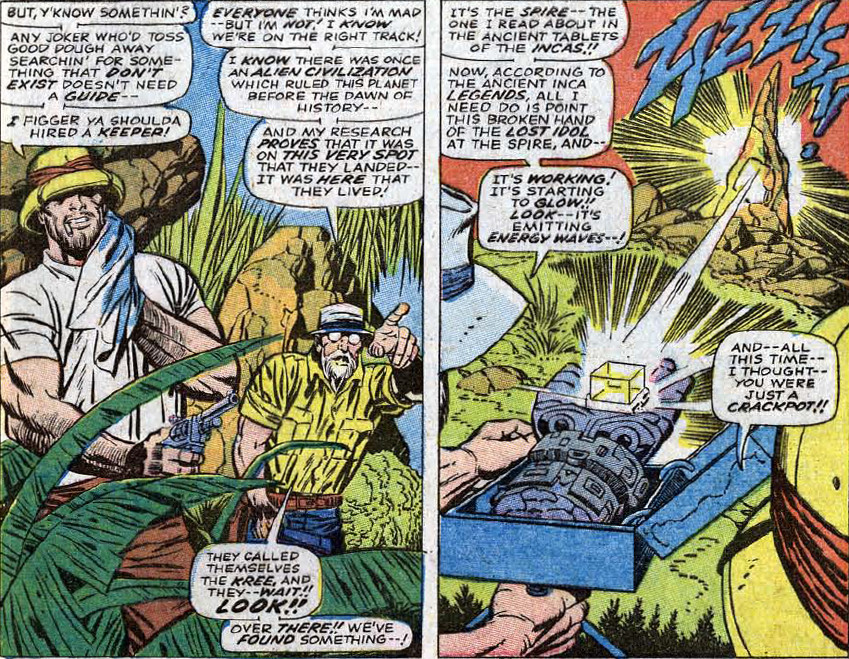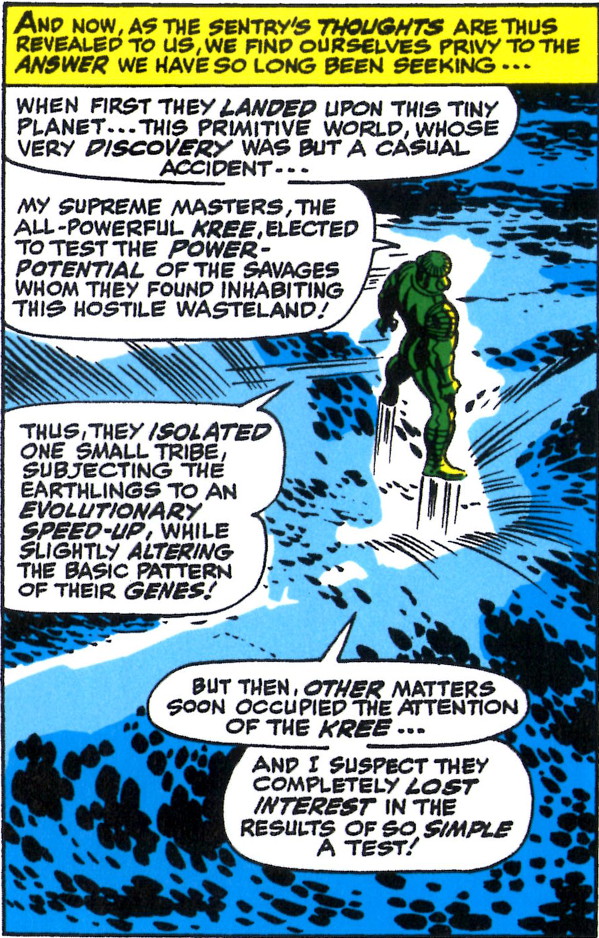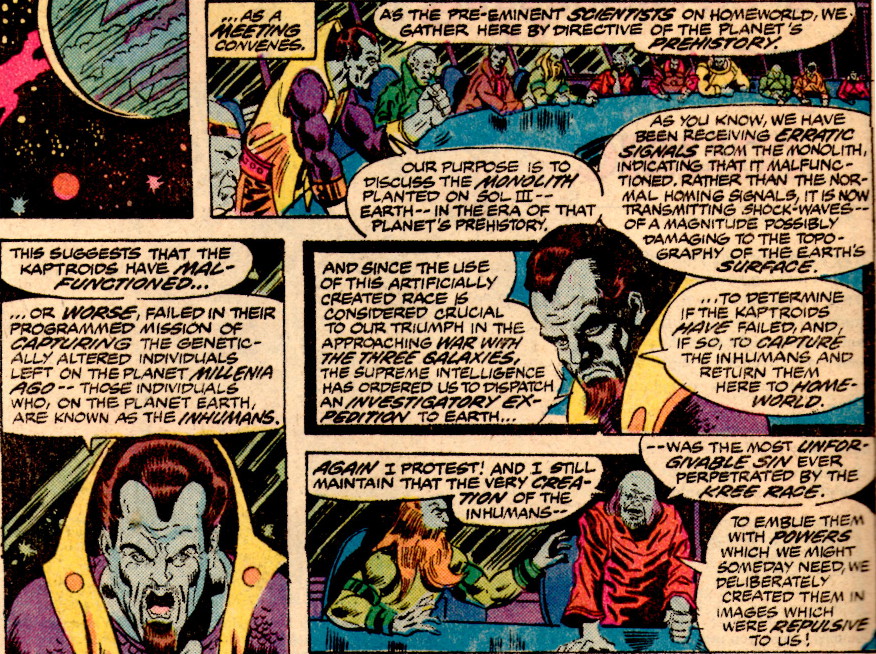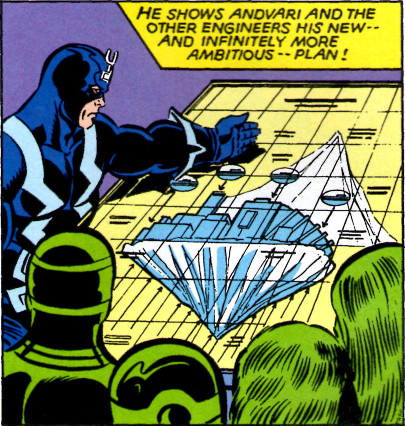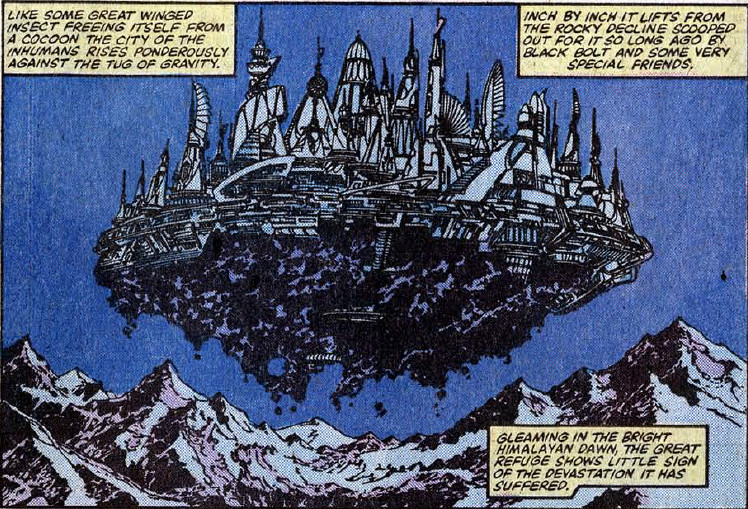The Kree and the Inhumans
One of the most intriguing aspects of the Inhumans is the ultimate explanation of how they evolved leaps and bounds beyond their human brethren. When Kirby and Lee first introduced their origin in Fantastic Four #46, published in January of 1966, the Seeker simply said that the race of Inhumans dates back to pre-historic days when they were creating an advanced civilization, while humans were still living in caves and attacking each other with clubs.
There was no hint of an extraterrestrial involvement in the course of Inhuman history until Fantastic Four #64, published in July of 1967. This issue is the first time that the Kree show up in Marvel comics.
After some preliminary pages associated with cleanup from the previous issue, the story switches to focus on two explorers who’ve come ashore to explore an uncharted island ‘a half a world away’ from our heroes.
The ‘energy waves’ emitted by the professor’s gadget quickly reveal a subterranean lair of the Kree. The two enter and soon find themselves witness to the amazing, millennia-old, remains of the alien race of the Kree, who walked on the Earth in ages past. As the pair enters the abandoned space port, the guide begins shooting at a monster in the shadows. The monster, stepping forward into the light, announces itself as Inter-galactic Sentry 459.
Owing to some strange coincidence having to do with selling comic books, at the same time these events are happening on the island, our intrepid team decides to take a vacation in the same region of the world. By the time Reed, Sue, and Ben have packed and are in route to the South Seas, the Sentry has erected a force field extending in all directions. The two parties are brought into close and violent contact when the FF’s plane collides with the force field. The melee that follows is pretty much a draw and ends when the base’s energy supply is breached and begins to build to an overload. The Fantastic Four retreat from the island while the Sentry stays behind to face his doom. In his last moments, the Sentry sends a message to the Kree Homeworld letting them know of the destruction of ‘outpost 10’.
The Homeworld’s response follows in the next issue (FF #65, Aug. 1967) in the form of a warning from Supreme Intelligence
that the team will be punished for the demise of the Sentry. Ronan the Accuser is dispatched, and shortly arrives on Earth
looking amazingly like Lee Pace
right after he heard about the cancellation of Pushing Daisies. Ronan seeks to punish the Fantastic Four for their crimes, but they resist arrest and, through a clever maneuver, manage to bring down on the Kree Accuser the very punishment meant for them. Seeing that he is beaten, Ronan’s transport whisks him away and the end comes to the first Kree storyline.
I don’t suppose that we’ll ever know if the Kree were introduced in these two issues as a prelude to weaving them into the Inhuman’s history or whether, once introduced, Lee and Kirby seized the opportunity. In any event, three months later, backup stories featuring the Inhumans began running in the Thor monthly title. The key issue is Thor #147 (Dec 1967) where we learn that the Kree experimented on a small tribe which became the Inhumans.
From this point on, the Kree become a mainstay in the Inhuman storyline, showing up from time to time, usually with disastrous results.
As discussed in the last post, the Inhumans maintained a strong presence in the Fantastic Four monthly until about 1975. In October of that same year, they were launched into a new bi-monthly book that focused on their relationship with the Kree. In this excerpt from issue #2, we find that the Kree regard the Inhumans as cannon fodder
genetically engineered as weapons in the upcoming War with the Three Galaxies. Maybe the creative team felt that they were onto something big but looking back at the series run it is clear that it was doomed to a short life. The plots were confusing and the writing ponderous and the bimonthly publishing schedule killed any momentum before it could build. By August of 1977 the series was canceled and the storyline hurriedly resolved in Captain Marvel #53 (Nov. 1977). Inhuman fever had run its course.
Over the next 30 years or so, the Inhumans were relegated to guest star status, showing up in a variety of books but with very little involvement in pivotal stories. The one exception to this was the reintroduction of Crystal into both the Fantastic Four and Avengers monthlies, but that is a tale for another day.
Modern days have seen a resurgence of interest in publishing stories about the Inhumans (in both comic and in the Cinematic Universe). I won’t dwell on these as there are very good summaries available on the web but I will note that one of the arcs, called the War of Kings, involves the Black Bolt assuming the rule of the Kree empire.
The Moving City of Attilan
One of the most fantastic aspects of the Inhuman canon is the notion that their home can actually be relocated – not only from place to place on the Earth – but off of the Earth as well. When first introduced, the city of the Inhumans bore only the name ‘The Great Refuge’. This name stuck for a number of years but finally in Thor #146 (Nov 1967), we found out that its proper name was Attilan.
When it first appeared, Attilan was on an island far from the Himalayas. It was to this island paradise that the Kree Sentry, who conveniently shared his thoughts about the ultimate origin of the Kree, visited them so many millennia ago.
So then how did the city relocate from seaside to mountain? Well, it took about 13 years for that answer to surface in What If #29 and #30 (Oct and Nov 1981). It seems that as a young man, Black Bolt decided to move the entire city, in one go, from the sea to a more attractive clime in the mountains of Nepal.
His outward reason being fear of rising humanity, but I often think it was simply that island life was too hot for someone who wears a skin-tight, black costume covering him from head to toe. Whatever the reason, this brief storyline is notable in that it links the Inhumans to another genetically modified human offshoot, the Eternals (yet another Kirby creation).
I don’t know how many years elapsed between Attilan’s settlement in the Himalayas and the first visit by the Fantastic Four, but soon after, the pollution of the human world finally chases the city from the Earth entirely. Fantastic Four #240 (March 1982) chronicles the relocation of Attilan to the legendary Blue Area of the Moon, where a small earth-like atmosphere exists, free of contaminants.
Somewhere in the intervening time, Attilan returned to Earth where it was subsequently destroyed (not to worry it is destroyed and rebuilt often in the course of ‘ordinary’ events) and the Terrigen mists, exposure to which makes each Inhuman acquire their unique power, were released all over the Earth.
Okay, next week I will actually talk about who Calvin Zabo and then I’ll try to tie all of this back into Agents of Shield.


